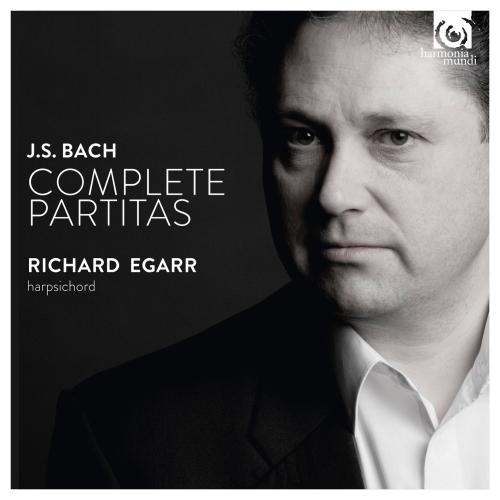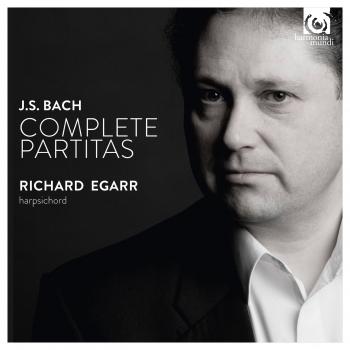
Bach: Partitas, BWV 825-830 Richard Egarr
Album info
Album-Release:
2017
HRA-Release:
24.02.2017
Label: Harmonia Mundi
Genre: Classical
Subgenre: Instrumental
Artist: Richard Egarr
Composer: Johann Sebastian Bach (1685-1750)
Album including Album cover Booklet (PDF)
- Johann Sebastian Bach (1685-1750):
- 1 Partita No. 1 in B-Flat Major, BWV 825: I. Praeludium 02:02
- 2 Partita No. 1 in B-Flat Major, BWV 825: II. Allemande 04:28
- 3 Partita No. 1 in B-Flat Major, BWV 825: III. Corrente 03:01
- 4 Partita No. 1 in B-Flat Major, BWV 825: IV. Sarabande 04:43
- 5 Partita No. 1 in B-Flat Major, BWV 825: V. Menuets I & II 03:15
- 6 Partita No. 1 in B-Flat Major, BWV 825: VI. Gigue 02:37
- 7 Partita No. 2 in C Minor, BWV 826: I. Sinfonia 04:48
- 8 Partita No. 2 in C Minor, BWV 826: II. Allemande 04:33
- 9 Partita No. 2 in C Minor, BWV 826: III. Courante 02:11
- 10 Partita No. 2 in C Minor, BWV 826: IV. Sarabande 03:08
- 11 Partita No. 2 in C Minor, BWV 826: V. Rondeaux 01:49
- 12 Partita No. 2 in C Minor, BWV 826: VI. Capriccio 04:17
- 13 Partita No. 4 in D Major, BWV 828: I. Ouverture 05:53
- 14 Partita No. 4 in D Major, BWV 828: II. Allemande 11:20
- 15 Partita No. 4 in D Major, BWV 828: III. Courante 03:38
- 16 Partita No. 4 in D Major, BWV 828: IV. Aria 02:18
- 17 Partita No. 4 in D Major, BWV 828: V. Sarabande 05:40
- 18 Partita No. 4 in D Major, BWV 828: VI. Menuet 01:31
- 19 Partita No. 4 in D Major, BWV 828: VII. Gigue 04:16
- 20 Partita No. 3 in A Minor, BWV 827: I. Fantasia 02:35
- 21 Partita No. 3 in A Minor, BWV 827: II. Allemande 03:21
- 22 Partita No. 3 in A Minor, BWV 827: III. Corrente 03:15
- 23 Partita No. 3 in A Minor, BWV 827: IV. Sarabande 03:27
- 24 Partita No. 3 in A Minor, BWV 827: V. Burlesca 02:17
- 25 Partita No. 3 in A Minor, BWV 827: VI. Scherzo 01:24
- 26 Partita No. 3 in A Minor, BWV 827: VII. Gigue 04:14
- 27 Partita No. 3 in A Minor, BWV 827: VIII. Gigue (alternative version) 04:17
- 28 Partita No. 5 in G Major, BWV 829: I. Praeambulum 02:44
- 29 Partita No. 5 in G Major, BWV 829: II. Allemande 04:47
- 30 Partita No. 5 in G Major, BWV 829: III. Corrente 02:13
- 31 Partita No. 5 in G Major, BWV 829: IV. Sarabande 04:07
- 32 Partita No. 5 in G Major, BWV 829: V. Tempo di Minuetta 02:16
- 33 Partita No. 5 in G Major, BWV 829: VI. Passepied 01:47
- 34 Partita No. 5 in G Major, BWV 829: VII. Gigue 04:48
- 35 Partita No. 6 in E Minor, BWV 830: I. Toccata 06:39
- 36 Partita No. 6 in E Minor, BWV 830: II. Allemande 04:00
- 37 Partita No. 6 in E Minor, BWV 830: III. Corrente 04:55
- 38 Partita No. 6 in E Minor, BWV 830: IV. Air 01:40
- 39 Partita No. 6 in E Minor, BWV 830: V. Sarabande 06:04
- 40 Partita No. 6 in E Minor, BWV 830: VI. Tempo di Gavotta 02:08
- 41 Partita No. 6 in E Minor, BWV 830: VII. Gigue 06:10
Info for Bach: Partitas, BWV 825-830
Any composer s Op.1 is a big deal. Bach modelled his own after Kuhnau s 'Neue Clavier Übung', books 1 and 2 of which were published in 1689 and 1692. Bach s ability to see and create a long-term project has its spooky beginnings here. Although the music that inhabits the six Partitas was ready and waiting, rather than publish them together, Bach staggered their delivery. Partita 1 came in 1726, with the other five appearing gradually over the next four years, until finally in 1731 the entire six Partitas were presented as his Clavir [sic] Ubung . . . Opus 1 . . . 1731 . Bach infuses this seemingly effortless music with godly patterns and personal algorithms of stunning brilliance. Many pages have been spent in the pursuit of secret codes in Bach s music: for many, a contentious subject. Bach began by publishing Partita 1 in 1726 when he was 41 years old. Needless to say the final movement of the set (the 41st movement), has as its theme a subject containing 14 notes. The family name not only gave rise to a direct musical melody [BACH = B flat/A/C/B natural], but for Johann Sebastian a pair of deliciously mirrored numbers with which he was wont to sign his name at beginnings and endings in particular. If A=1, B=2 etc. (I and J are counted as the same letter), then: BACH = [2+1+3+8] 14 JSBACH = [9+18+14] 41 The above is wilfully paraphrased from Richard Egarr's own superb notes from this new recording of the Partitas; crowning his already extensive series of Bach's harpsichord works, and illuminating every one of their multiple facets.
Richard Egarr, harpsichord
Richard Egarr
brings a joyful sense of adventure and a keen, enquiring mind to all his music-making. He is equally happy conducting, directing from the keyboard or playing concerti (on organ, harpsichord, fortepiano or modern piano), giving solo recitals, playing chamber-music, and indeed talking about music at every opportunity.
Music Director of the Academy of Ancient Music since 2006, Egarr has further renewed his contract to 2017. AAM began a new relationship in September 2012 as Associate Ensemble at the Barbican Centre, where plans include a cycle of Monteverdi operas. Early in his tenure Egarr established the Choir of the AAM, and operas/oratorios lie at the heart of his repertoire; in 2010 he conducted Mozart’s opera La Finta Giardiniera in concert at the Barbican Centre and the Theatre des Champs-Elysees. He made his Glyndebourne debut in 2007 conducting a staged version of The Matthew Passion. Egarr is a lasting inspiration to young musicians, maintaining regular relationships at the Amsterdam Conservatoire, Britten Pears Foundation, and the Netherlands Opera Academy (La Clemenza di Tito, Le Nozze di Figaro and Rossini’s Il Signor Bruschino) and is a Visiting Artist at the Juilliard School in New York.
Egarr was recently announced Principal Guest Conductor of the Residentie Orchestra in The Hague, having regularly guest-conducted the orchestra in recent years. Starting in September 2013 he will conduct three projects each season, with a brief to further explore eighteenth- and nineteenth-century performance practices, launching with a performance of Haydn’s Creation in December 2013.
Egarr has a flourishing career as a guest conductor with orchestras ranging from Boston’s Handel and Haydn Society where he is an annual guest, to the London Symphony, Royal Concertgebouw and Philadelphia orchestras. In 2011 he was appointed Associate Artist of the Scottish Chamber Orchestra in recognition of his growing relationship with the ensemble.
He continues to play recitals across the world, returning to the Wigmore Hall in January 2014 for a solo harpsichord recital, and in January 2013 played the Bach English Suites in London and Cambridge to coincide with his latest Harmonia Mundi release. Notable amongst an impressive discography are the Goldberg Variations and Well-Tempered Clavier, Mozart fantasias and rondos, and the complete harpsichord works of Louis Couperin, also many award-winning duo recordings with Andrew Manze. His growing list of recordings directing the Academy of Ancient Music includes seven Handel discs (2007 Gramophone Award, 2009 MIDEM and Edison awards), the complete Brandenburg Concerti, and Birth of the Symphony - Handel to Haydn, the first recording released on the AAM’s own label in September 2013.
Egarr trained as a choirboy at York Minster, at Chetham’s School of Music in Manchester, and as organ scholar at Clare College Cambridge. His studies with Gustav and Marie Leonhardt further inspired his work in the field of historical performance.
Booklet for Bach: Partitas, BWV 825-830









